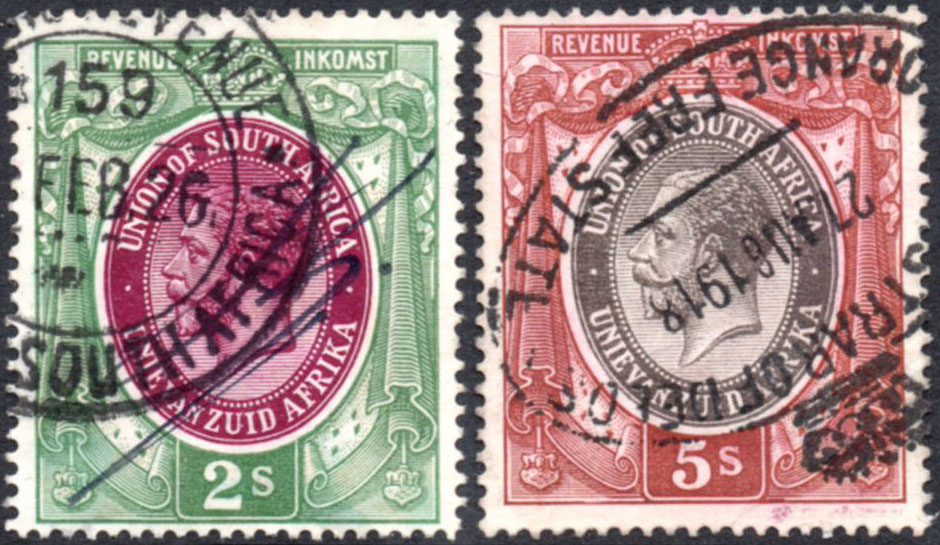| Revenue stamps of most British Commonwealth countries are fantastic things to collect. Often printed by the same companies who printed the stamps, common designs similar to the postage stamps are often used, though sometimes in a larger format. Like the postage stamps of South Africa, the revenue stamps were inscribed bilingually. At first both languages appeared on one stamp. From 1946 the revenue stamps were inscribed bilingually throughout the sheet, so one stamp would be in Afrikaans, the next would be in English etc. Because revenue stamps were often not widely collected at their time of issue, you are unlikely to find large quantities of mint revenue stamps, or multiples, cylinder blocks etc. For this reason the KGVI bantam issues in complete units and 1946/52 issue in complete bilingual pairs are quite scarce, also most KGV to early QEII period issues are very hard to find in mint condition with original gum. If you can find pairs, the bilingual issue of 1946/52 mostly come in vertical pairs, due to the layout of the documents that they were used on. The space available to apply the revenue stamps is usually a strip of margin at the left or right of the document, often not wide enough to apply a horizontal pair. Indeed it is generally only philatelists that care whether their bilingual pairs are horizontal pairs, certainly not the clerk toiling away to apply the correct tax to a pile of documents! |
King George V
There are two types of revenue stamp issued during this reign. The first, issued on 1st September 1913 is similar to the King’s Heads postage stamps issued in the same year. It utilises the same Mackennal head design of the King’s profile. All of the stamps are bicoloured. The 1s, £1 & £2 values were issued in changed colours in 1915, 1917 & 1914 respectively.
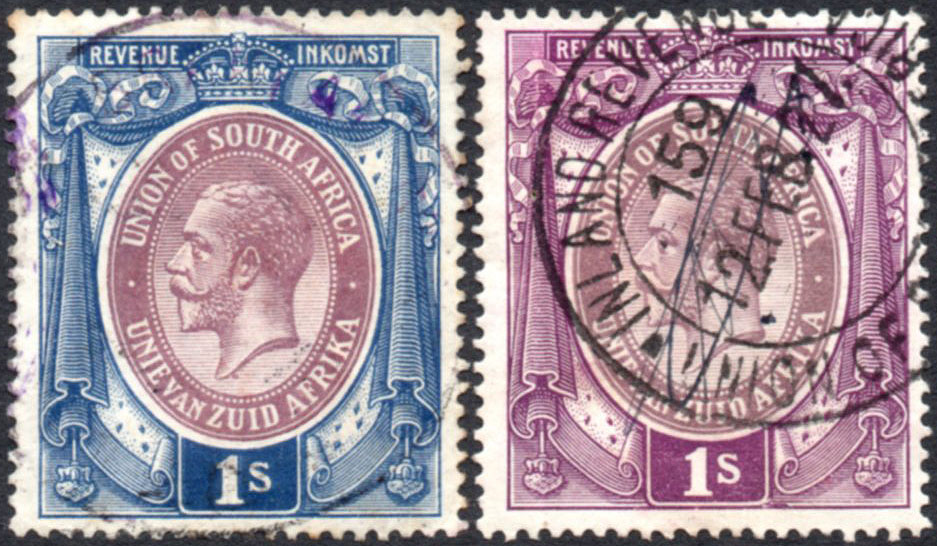
Prior to the official date of issue, during July 1913, some offices in the Cape ran out of 3d, 6d and £1 revenue values, so it was approved by the Secretary of Finance to use three of the new values before 1st September.
CAUTION – the colours of the first issue stamps run in water, so they are often best left on piece.
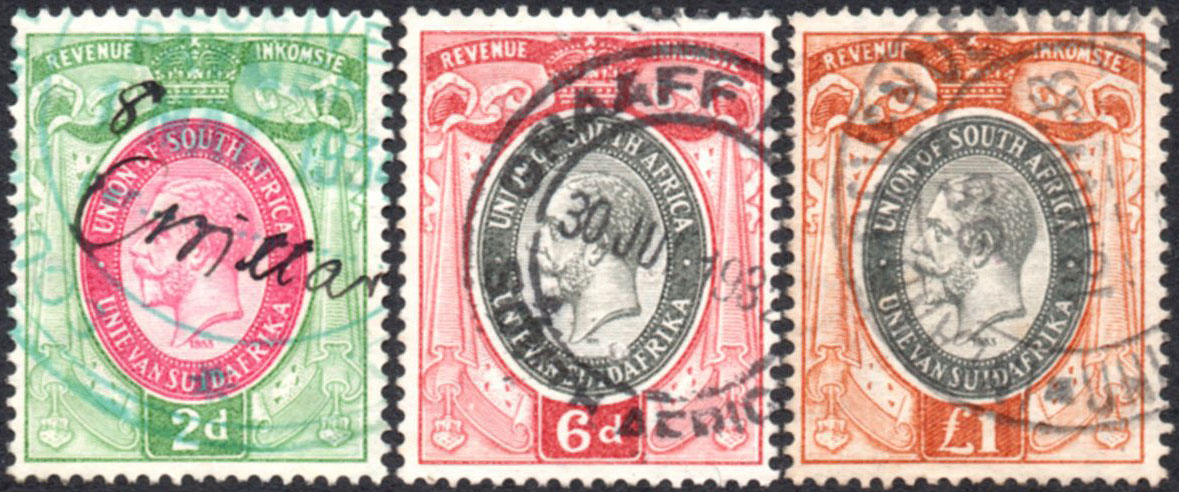
The second KGV issue was released in 1931 and was a smaller format to the previous one. Again, the stamps are bicoloured and now have the year or printing incorporated into the design, just below the point of the neck of the King. The years are shown in four digits and can be found from 1931 & 1933/7. The majority of values can be found with most years apart from the 15s, which was only issued in 1937 and can be difficult to find.
King George VI
This reign has three different sets, two of which have some quite interesting design alterations made during their period of issue. The first set appeared in 1938 and was in use until 1942. The 1938 issues have the year of issue below the neck of the King and are inscribed in four digits. Between the years 1939/42, this was reduced to two digits, slightly larger and therefore easier to read. All values appear with the 1938 date except the 15s, this being first issued in 1939. There was also a change to the country inscription on the 2s6d in 1941 & 1942. This value was first issued in 1938 with Afrikaans the language to the left of the King’s portrait. It was reprinted in 1939 & 1940 in the same format. Then in 1941 & 1942 the country names were switched and the name in English appeared to the left of the King’s portrait.

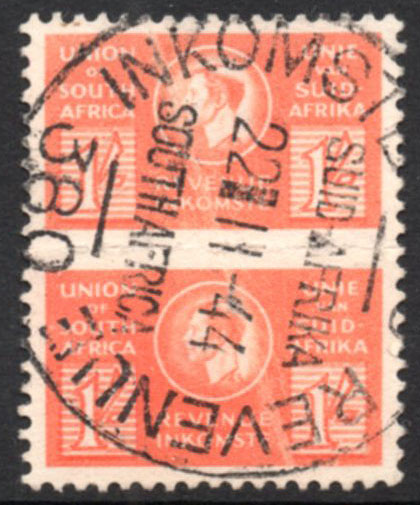
During the war, which South Africa entered in 1941, the same paper saving measures were applied to the revenue stamps as were applied to the postage stamps, hence we see revenues in the “Bantam” format. They were printed as pairs in a horizontal format and separated by a roulette perforation, gauge 6½. The format is identical to the 1s Bantam War Effort postage stamp, SG 104. The Bantam revenues were inscribed bilingually, so they do not alternate in language throughout the sheet. The date appears, in two digits, inside the oval, below the King’s head.
One of the most interesting revenue issues of the whole British Commonwealth was the 1946/52 set of South Africa. This third KGVI set has several design variations that reflect the same variations found on the postage stamps. All of the stamps have the year in two digits below the King’s portrait. The first two years, 1946 & 1947, were printed using an unscreened rotogravure process. From 1948 the revenue stamps were printed using a screened rotogravure process, where the design appears as small dots under a glass. In 1952 the stamps were redrawn, the designs were slightly smaller, the background lines behind the King’s portrait are finer and the portrait is more defined.
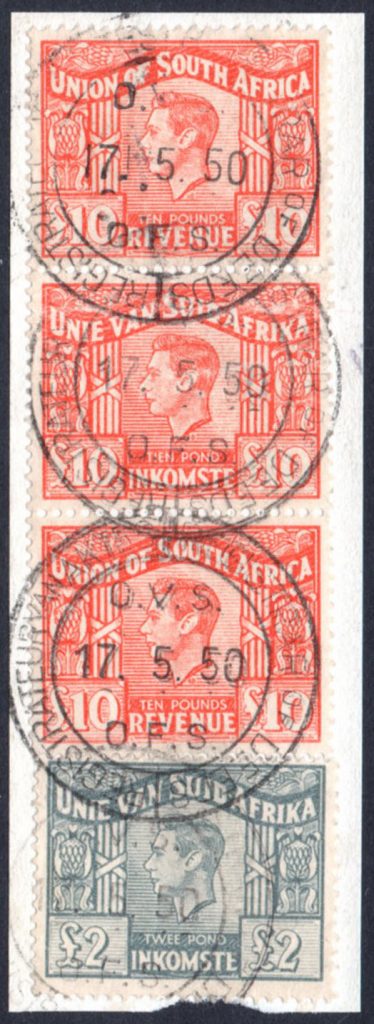
The last KGVI issue also has language errors, where the two different plates used for printing the stamps were transposed. Hence a stamp with the country name “Union of South Africa” in English, has the Afrikaans word for revenue, “Inkomste” rather than the English word and vice versa. This error can be found on the 6d, 1s6d, 2s, 3s & 5s stamps.
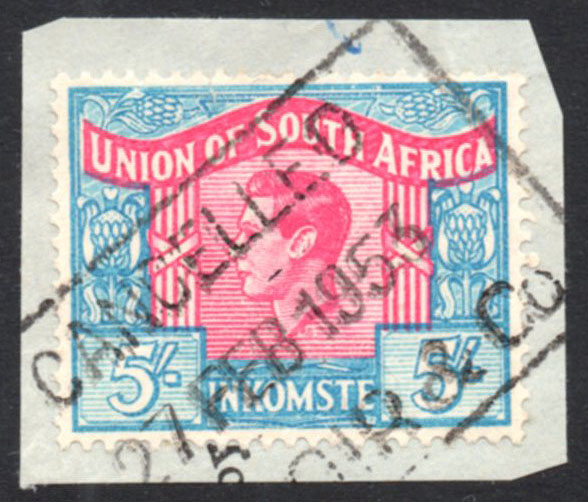
The last KGVI issue also has language errors, where the two different plates used for printing the stamps were transposed. Hence a stamp with the country name “Union of South Africa” in English, has the Afrikaans word for revenue, “Inkomste” rather than the English word and vice versa. This error can be found on the 6d, 1s6d, 2s, 3s & 5s stamps (shown).
The foregoing only applies to the widely used Revenue Stamps. They also appear with various overprints such as ASSIZE, CONSULAR, CUSTOMS DUTY and PENALTY, their usage destined for specific areas. The ASSIZE overprinted stamps were used on the receipts for the fee for an annual check of public Weights & Measures equipment, for example.
The Revenue Stamps continued to be issued through QEII’s reign and into the Republic period. Most Revenue Stamp collectors use and refer to the Barefoot catalogues.
